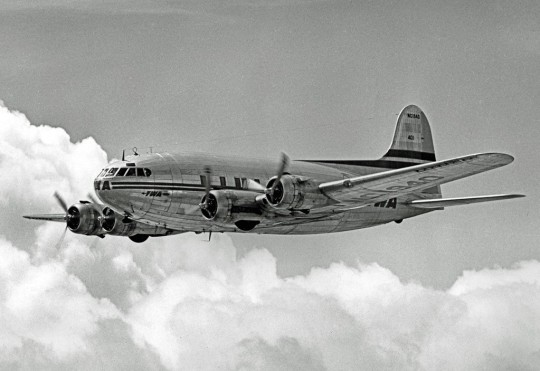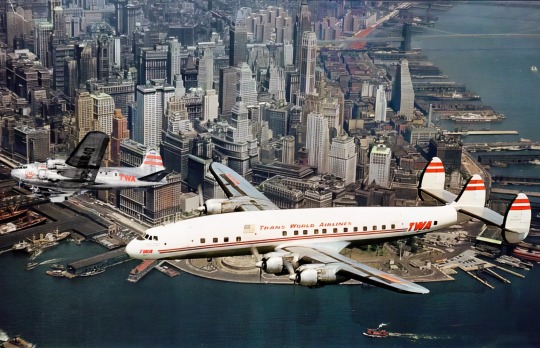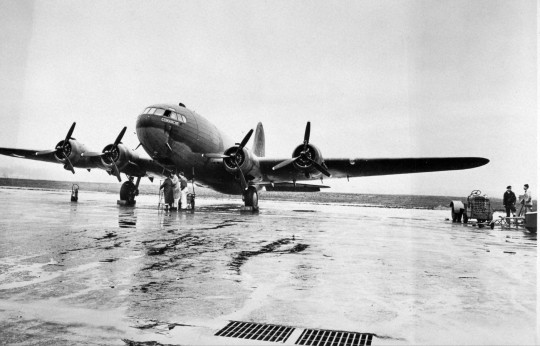#boeing stratoliner
Explore tagged Tumblr posts
Text

The luxurious interior of a TWA Boeing 307 Stratoliner - 1940.
#vintage illustration#vintage aircraft#aircraft#commercial aircraft#civilian aircraft#airplanes#vintage airplanes#passenger planes#airlines#airliners#stratoliner#luxury travel#luxury air travel#boeing#boeing 307 stratoliner#boeing 307#boeing stratoliner#the 40s#the 1940s#twa#trans world airlines
45 notes
·
View notes
Text

1940 photo of a TWA Boeing 307B Stratoliner
#Boeing#307#Stratoliner#Boeing 307#B307#airliner#passenger plane#commercial aviation#flying#vintage aviation#airplane#plane
89 notes
·
View notes
Text

Boeing 307 Stratoliner at the Pima County Air Museum, later Pima Air & Space Museum, in Tucson, Arizona.
Date: February 1970
SDASM Archives: 72694621
#Boeing 307 Stratoliner#Boeing 307#307 Stratoliner#307#Passenger Aircraft#Aircraft#Airplane#Pima Air & Space Museum#Tucson#Arizona#February#1970
56 notes
·
View notes
Photo

Boeing 307B Stratoliner. NC1940. TWA. Originally NX19906. Spent some time in service with the US military as an C-75
290 notes
·
View notes
Text

Boeing 307 Stratoliner of the Pan American Airlines
Dutch vintage postcard
#old#postcard#postkaart#stratoliner#pan american airlines#vintage#american#briefkaart#postal#ansichtskarte#ephemera#photography#photo#307#boeing#postkarte#tarjeta#airlines#dutch#pan#historic#sepia#carte postale
5 notes
·
View notes
Text

A TWA Lockheed Constellation, and a TWA Boeing 307 Stratoliner VIDEO 🎥 https://youtu.be/R7AOf02jvv4
#youtube#aircraft#airplane#aviation#dronescapes#documentary#TWA#aviation lovers#aviation photography#boeing#lockheed#lockheed constellation#boeing 307#new york#new york city#aviation history#aviation industry#airplanes#planes
72 notes
·
View notes
Text
I wish there were more model kits focused on civilian aviation, I like an f-35 as much as the next guy but what I really want is a Boeing stratoliner
1 note
·
View note
Text
The Evolution of Air Travel: From Wright Brothers to Supersonic Jets
Air travel has transformed significantly since the Wright Brothers first took to the skies in 1903. Over the past century, advancements in aviation have reshaped how people and goods move across the globe. This article explores the remarkable journey of air travel, from primitive gliders to the sophisticated supersonic jets of today, detailing key innovations and pivotal moments that have propelled the aviation industry forward.
Pioneering the Skies: The Wright Brothers' Legacy
The aviation story begins with two visionary siblings, Orville and Wilbur Wright. On December 17, 1903, they achieved the first powered, controlled, and sustained human flight near Kitty Hawk, North Carolina. The Wright Flyer, a fragile biplane, soared for a mere 12 seconds, covering 120 feet. This historic flight laid the foundation for modern aviation, setting the stage for a century of aerodynamic research and technological development.
Their invention sparked interest worldwide, leading to rapid aircraft design and capabilities enhancements. By the 1920s, airplanes evolved from wood-and-fabric constructions to more durable designs featuring metal skins and robust engines, enabling longer and more reliable flights.
The Golden Age of Air Travel
The period between the 1930s and 1950s is often called the "Golden Age of Air Travel." Significant advancements were made during this era, including the introduction of pressurized cabins in the Boeing 307 Stratoliner, which allowed commercial planes to fly higher and avoid weather disturbances. This era also saw the rise of iconic aircraft such as the Douglas DC-3, which became the backbone of the global airline industry due to its reliability and efficiency.
Luxury also became a hallmark of air travel during this time. Airlines like Pan American World Airways offered glamorous services, including elegant dining and spacious seating, setting a high standard for international travel and making flying a prestigious affair.
Jet Age Revolution
The advent of the Jet Age in the mid-20th century marked another pivotal shift in aviation history. The development of the jet engine led to aircraft like the Boeing 707 and the Douglas DC-8, which dramatically reduced travel time and connected continents faster than ever before. This period saw a boom in commercial aviation, making air travel accessible to the masses and not just the wealthy elite.
The efficiency and speed of jet travel expanded the airline industry's reach, providing unprecedented growth in tourism and business travel. International travel became more feasible, fostering greater cultural exchange and global connectivity.
The Supersonic Dream and its Challenges
In the quest for speed, the aerospace industry ventured into supersonic travel. The Concorde, a turbojet-powered supersonic passenger airliner, became the epitome of high-speed travel when it commenced service in 1976. Capable of cruising at twice the speed of sound, the Concorde could reduce the flight time between New York and London to under three hours.
However, the dream of mainstream supersonic travel faced numerous challenges. High operational costs, environmental concerns over sonic booms, and limited seating capacity led to the Concorde's retirement in 2003. Despite its commercial struggles, the Concorde remains a significant technological achievement and a symbol of what future air travel might still aspire to achieve.
Modern Advancements and the Future of Flight
Today, the aviation industry focuses on sustainability and efficiency. Modern aircraft have advanced materials, more fuel-efficient engines, and innovative aerodynamic designs to reduce environmental impact. Companies like Boeing and Airbus have introduced models such as the 787 Dreamliner and the A350, which offer long-range capabilities with significantly reduced fuel consumption and carbon emissions.
Looking ahead, the industry is exploring revolutionary concepts, including electric-powered aircraft and even the potential return of supersonic passenger jets with modern technology to mitigate past challenges. Start-ups and major aerospace firms are racing to develop viable electric planes that promise to be quieter, cleaner, and more cost-effective.
A Century of Skyward Ascent
From the Wright Brothers' first flight to the sleek jets that now crisscross the skies, the evolution of air travel reflects human ingenuity and the relentless pursuit of progress. Each aviation era has brought challenges and breakthroughs, driving continuous improvement in how we fly. As technology advances, the following chapters of air travel will likely be marked by innovations that make flying even more accessible, sustainable, and faster than ever before.
0 notes
Text
A Comprehensive Guide to Pressure
By Arjuwan Lakkdawala
Ink in the Internet
It is one of the fundamental forces that we live with and is used in scientific inventions.
We seldom feel it but it plays a major part in the world.
In this article I'm going to concentrate on the ways in which pressure effects us and the world.
Human body: Blood pressure in the body is the force of the blood against the vessel walls as it makes each cardiac cycle to deliver oxygen to the organs and tissue.
High blood pressure (Hypertension) can damage many organs and be fatal.
Pressure is highest close to the heart and lower in other parts.
Now to consider the pressure outside the body, which is atmospheric pressure.
We live at the bottom of the atmosphere, all that air has weight which is called atmospheric pressure. On every square inch of Earth's surface is 14.7 pounds of air pressure pushing down.
Yet it doesnt crush us and we don't feel any pressure. That is because air is a fluid.
If you stretch your arm before you and observe. The air is pushing on your hand from every direction and this is why the force of atmospheric pressure cancel each other out.
If there was pressure on one side and not the other, the other side would feel the air pressure pushing on it. This is how jars are factory sealed for example. The lid is held tightly on the glass because inside the jar is a vacuum.
In Earth's weather there is High Pressure Systems and Low Pressure Systems.
On a weather map red L is for LP and blue H is for HP.
These systems are because Earth is not equally heated by the sun, and because of its rotation and the Corialis effect.
Pressure on the Earth's surface varies, and it is effected by air density, temperature, and volume. Air temperature is measured in Kelvin.
Atmospheric scientists use math equations to explain how pressure, density, temperature, and volume are connected. The Constant in the Equations is the Universal Gas Constant and the equations are called the Ideal Gas Law.
Where air pressure is high the temperature is low, and as temperature increases air pressure gets lower.
Now if we are to go higher literally in altitude. Like when flying on a plane, many passengers might have experienced Airplane Ear or Ear Barotrauma, it is when the air pressure inside the ear and the cabin pressure inside the plane are not equal.
The Eustachian Tube inside the ear gets flattened because of the pressure change during ascend or descend. So the safe way to pop your ear is to yawn or swallow to get air into the ear which will equalise the pressure.
When it comes to pressure and flight I'm not done. I know a little more I can write about.
In the 1930s Boeing introduced a special commercial plane Stratoliner 307 which had pressurised cabins. The technology hasnt changed since but has become more precise with the advent of electronic computerised sensors. This pressurised air in the cabins is regulated to gradually increase and decrease as the plane ascends and descends.
The air used is from the jet engine compressors. When the engines pull in air for combustion it's more than it needs for the plane to fly. So volumes of the air are taken into the plane system for air conditioning and cabin pressurisation.
Now I have a little more knowledge about flight and pressure I can write about.
There are many mechanisms and engineering skills that go into making aircrafts. But it is still unknown how planes really fly in full detail.
What is known are leading theories of the Bernoulli Principle and Newton's Third Law of Motion.
In his 1738 book Hydrodynamica, Daniel Bernoulli, wrote that a fluid when moving fast has less pressure than when moving slow. Air is not liquid but it is considered a fluid. So the fast moving air created by the aircrafts is said to be why they fly. Again pressure is the theory.
Newton's Third Law of Motion states that for every action there is an opposite and equal reaction. Air has mass therefore there is air pressure, and again flight is attributed to the airfoil and jet engines that create lift using the Third Law.
Basically when the jet engines start the compressors pull enormous amounts of air, this air is then compressed and sent to the combustion chamber where it is sprayed with fuel and ignited. As it exits the nozzle thrust is made. The pressurised air has high combustion qualities.
Now if we are to go literally even higher in a rocket. It too uses combustion for take off but is engineered different from aircrafts.
What happens to the human body in microgravity which is in low-Earth orbit. Astronauts may develope many health complications in space. Micrpgravity on the International Space Station, may specifically cause vision loss as blood flows towards the head from the rest of the body.
A NASA reports says Astronauts wear compression cuffs on the thighs to counter the fluid change, a negative-pressure device worn to draw blood away from the head to the lower extremities of the body.
What happens if an astronaut goes out of the spacecraft into the vacuume of space without a spacesuit. There is no atmospheric pressure and the oxygen in the lungs would expand causing the lungs to rupture. The fluids in the body would boil as it is pressure that sets the boiling point of liquids. So the boilling point of the fluids will be lowered in the vacuume of space, and bubbles and boiling will happen as the fluids turn to gas. Medically this is called embolism.
Now let us return to earth and go into the water. What happens under the sea to body pressure. Scuba divers use compressesed air to breathe under water. It has nitrogen, oxygen, and other gases in the mixture. The nitrogen can cause Nitrogen Narcosis, making the diver disoriented and could lead to coma. Another problem is decompression illness, this is why divers should not go to altitudes like in a plane or mountains immediately after diving. The nitrogen they inhale during the dive enters the bloodstream and with the decreased pressure at altitudes may form into bubbles as it exits the body. The nitrogen will exit the body after a diver has stopped diving, but it should happen gradually not suddenly as would happen at altitudes.
In this as well we have learned how pressure effects us and how it is used
It is pressure again that makes a boat float.
The air pressure inside the boat pushes against the water, when it is greater than the weight of the boat it will float.
Copyright ©️ Arjuwan Lakkdawala 2023
Arjuwan Lakkdawala is an author and independent journalist. Twitter/Instagram: Spellrainia email: [email protected]
Sources:
NASA - Rocket Educator Guide
NASA - Human in Space
Libre Texts Chemistry
High blood pressure dangers: Hypertension's effects on your body - Maya Clinic Staff
National Library of Medicine - AIMS Public Health. 2019; 6(3): 320–325.
Published online 2019 Aug 26. doi: 10.3934/publichealth.2019.3.320
PMCID: PMC6779601
PMID: 31637280
“Airplane ear”—A neglected yet preventable problem
Sudip Bhattacharya,1,* Amarjeet Singh,2 and Roy Rillera Marzo3
Author information Article notes Copyright and License information PMC Disclaimer
Airplane Ear - Mayo Clinic
Libre Texts Biology - 40.13: Blood Flow and Blood Pressure Regulation - Blood
NASA - How does a jet engine work
National Library of Medicine - Nitrogen Narcosis In Diving StatPearl (Internet)
Patrick J. Kirkland; Dana Mathew; Pranav Modi; Jeffrey S. Cooper.
Author Information and Affiliations
Last Update: July 31, 2023.
Direct Air - Breathing air - your compressed air responsibilities
Science questions with surprising answers - Dr. Christopher S. Bird -
Why don't I feel the miles of air above me that are crushing me down?
Category: Physics
Published: September 14, 2015
UCAR - Center for Science Education - The highs and lows of air pressure
CalOx - Why Divers Don’t Use Pure Oxygen and Safe Scuba Diving Tips
Harvard - science in the news - THE HUMAN BODY IN SPACE: DISTINGUISHING FACT FROM FICTION
Let's Talk Science est. 1993 - STEM Explained
Why do Ships Float? - Amy McDonald
0 notes
Text

1940 Boeing 307 Stratoliner taxing at Dulles Int'l
#Boeing#307#Model 307#Airliner#passenger plane#vintage aircraft#Clipper Flying Cloud#plane#airplane#Stratoliner
133 notes
·
View notes
Text

Boeing C-75 parked on the tarmac of an airfield.
Date: 1940s
SDASM Archives: 01_00091316
#Boeing 307 Stratoliner#Boeing 307#307 Stratoliner#307#Passenger Aircraft#Boeing C-75#C-75#Cargo Plane#Aircraft#Airplane#United States Army Air Corps#U.S. Army Air Corps#US Army Air Corps#Army Air Corps#Air Corps#USAAC#World War II#World War 2#WWII#WW2#WWII History#History#Military History#1940s#undated#my post
60 notes
·
View notes
Text
Microsoft Flight Simulator Releases Local Legend 10: Boeing 307 Stratoliner
http://dlvr.it/SrTc9k
0 notes
Photo

Boeing 307 Stratoliner de la Pan American Airways (Pan Am)
#Avant-guerre#Pre-war#Aviation civile#civil aviation#Avion de ligne#Airliner#Boeing 307#Boeing 307 Stratoliner#Stratoliner#Pan American AIrways#Pan Am
299 notes
·
View notes
Photo

https://pacificeagles.net/boeing-307-stratoliner/
Boeing 307 Stratoliner
In 1935 with design work for the B-17 well underway, Boeing decided to create a civilian airliner from the same basic design. Borrowing the wings, engines, landing gear and tail from the B-17 and marrying them to a new cylindrical fuselage designed to be pressurised, the new Model 307 promised much better performance than existing airliners. It could cruise at an altitude of 20,000ft, unlike contemporary planes that had to remain below 15,000ft. With the plane having the ability to fly higher than most weather systems, Boeing gave it the name “Stratoliner”.
Despite the advances promised by the 307, orders were relatively few. The first plane was destroyed when it crashed during a demonstration flight for Dutch airline KLM. Pan Am ordered two Stratoliners and later an additional four, and Trans World Airlines five. The first delivery was to the eccentric tycoon and adventurer Howard Hughes, who bought it for a round-the-world record attempt that was abandoned when Germany invaded Poland in September 1939. Pan Am took delivery of just four 307s before the war put an end to civilian aircraft production but TWA received all five that they ordered. These were named after native American tribes – Apache, Comanche, Navajo, Cherokee and Zuni.
With the outbreak of war in 1941 Pan Am’s 307s remained nominally in civilian service but were under the direction of the Army Air Forces’ Air Transport Command. These were assigned to fly on South American routes for the AAF. The five TWA planes were bought by the AAF and received the military designation C-75 but were flown by their original TWA crews under contract. These were assigned to ATC and initially flew two transatlantic routes: the northern route from Gander to Prestwick, and the southern one from Natal to Accra in the south.
For the first year of the war the C-75s were the only planes capable of nonstop transatlantic flight, although they had the pressurization gear removed and additional fuel tanks installed to make these flights more comfortable. These aircraft regularly flew ‘top brass’ across the Atlantic, including members of the Chiefs of Staff and Harry Hopkins, Roosevelt’s personal aide. A C-75 was also dispatched to China to collect the Doolittle raiders after all of their B-25s were lost.
In 1944 with sufficient numbers of purpose-built military transports available, the C-75s were reconditioned and sold back to TWA. They continued to serve the civilian market for years after the war, although seven were lost to accidents. One 307 serving with the French airline Aigle Azur may have been accidentally shot down by anti-aircraft fire during the Vietnam War in 1965.
Boeing C-75 Stratoliner Specifications
C-75
Boeing C-75 StratolinerRoleTransportCrew5: Pilot, co-pilot, engineer, 2 cabin crewPowerplant4x Pratt & Whitney R-1820-G102A (1,100hp)Speed215mph (cruise) 241mph (max)Ceiling23,300ftRange1,750 miles (internal)ArmamentOrdnanceDimensions74ft 4in (length) 107ft 0in (wingspan) 20ft 10in (height)Wing Area1486 sq.ft.Weight30,000lb (empty) 45,000lb (gross) Number produced5
75 notes
·
View notes

